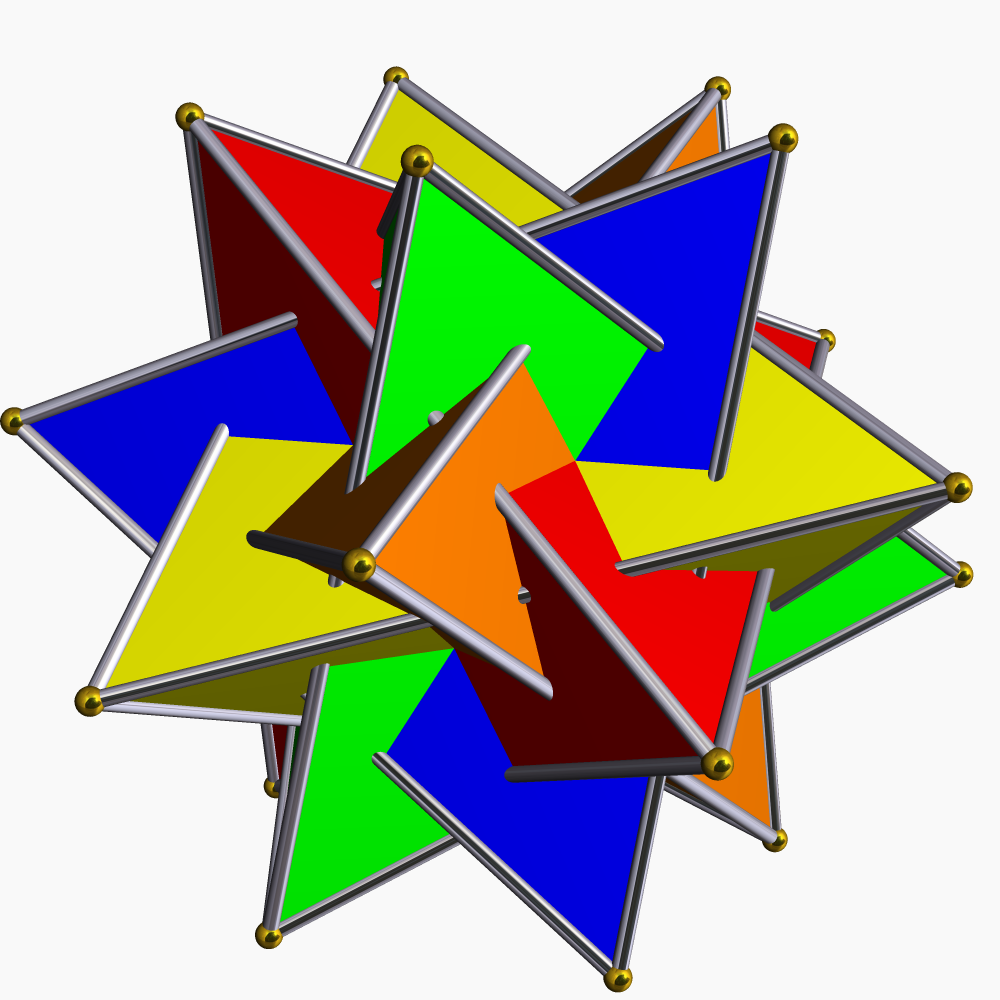
A regular icosahedron consists of 20 faces of equilateral triangles connected at 12 vertices. It's dual polyhedron is the dodecahedron whose 12 pentagonal faces meet at twenty vertices.
The dodecahedron can be described as the convex hull of the five-tetrahedra compound, which provides the "building blocks" for our permutations. In a five-tetrahedra compound, five identical regular tetrahedra are arranged concentrically so that their twenty vertices correspond with the vertices of a regular dodecahedron. We know, however, that there are only 60 rotational symmetries of regular icosahedra and dodecahedra, so all 120 permutations cannot represent rotations.
To see why, we can assign a number to each of the tetrahedra, and then each face of the dodecahedron can be described by the sequence of tetrahedra at the vertices in a clockwise direction. These are listed in the table below, along with the cycles corresponding to the permutations. Since there are only twelve faces, all twenty-four possible orderings are not possible. The cycles make it clear that all the faces are even permutations of 12345. In the table, I have chosen to begin all of the sequences with one, but that is only for convenience of notation. Any clockwise rotation of 2πn⁄5 through the center of each face is a rotational symmetry corresponding to the permutation (12345)n. Since (12345) is also even, we can rotate any face onto a given face, and then orient it any way we choose, all as even permutations of the five tetrahedra. Since we have 12 unique faces and 5 orientations, these 60 even permutations in the table below are identically the alternating permutation group of 5 elements, A(5). Therefore the rotational symmetry group of regular dodecahedra (and icosahedra) is isomporphic to A(5).
| Cycle | 1 | (243) | (23)(45) | (354) | (234) | (345) | (25)(34) | (235) | (24)(35) | (253) | (245) | (254) |
|---|---|---|---|---|---|---|---|---|---|---|---|---|
| Perm. | 12345 | 13425 | 13254 | 12453 | 14235 | 12534 | 15432 | 15243 | 14523 | 13542 | 15324 | 14352 |
| (12345)1 | 51234 | 51342 | 41325 | 31245 | 51423 | 41253 | 21543 | 31524 | 31452 | 21354 | 41532 | 21435 |
| (12345)2 | 45123 | 25134 | 54132 | 53124 | 35142 | 34125 | 32154 | 43152 | 23145 | 42135 | 24153 | 52143 |
| (12345)3 | 34512 | 42513 | 25413 | 45312 | 23514 | 53412 | 43215 | 24315 | 52314 | 54213 | 32415 | 35214 |
| (12345)4 | 23451 | 34251 | 32541 | 24531 | 42351 | 25341 | 54321 | 52431 | 45231 | 35421 | 53241 | 43521 |
Geometrically, if we start with the face where the tetrahedra are arranged 12345, then the first row could be interpreted as the rotation necesary to map the face described in the second row onto that face. This rotation will preserve the position of tetrahedron 1. The bottom four rows represent the composition of the rotation in the first row with the rotation about the axis through the center of the face, so that any face can mapped onto the orginal and be oriented in any of the five rotational symmetries of the pentagon.
